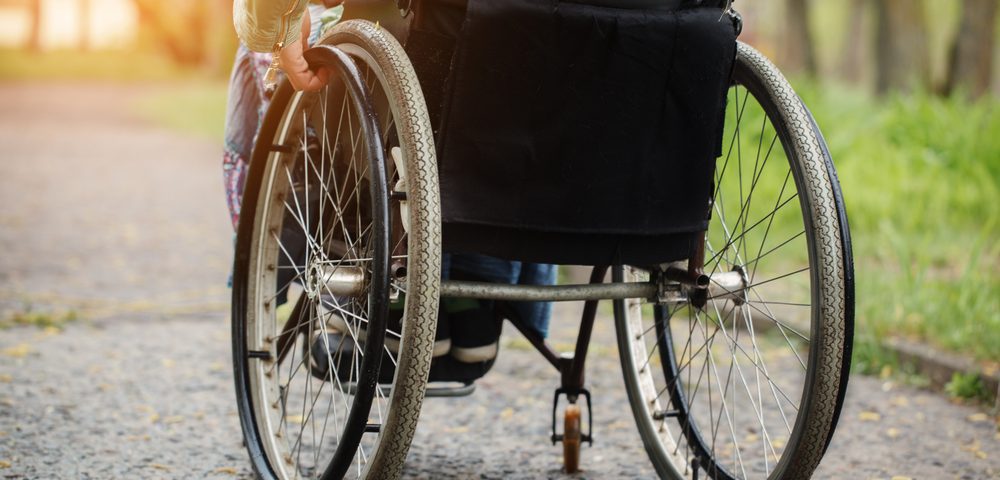On Being a Hot Person in a Wheelchair

Across social media platforms right now, there’s a trend where people post pictures of themselves from 10 years ago next to current ones. The idea is to see how much people have changed over a decade and to laugh at embarrassing old images. It’s been entertaining, especially for my generation, to watch friends post their middle-school yearbook photos next to their obviously filtered profile pictures.
Being me, I jumped on this bandwagon and posted a picture from 2010 of me in a hospital bed right before a sleep study, next to a picture of me in my Daredevil costume from Halloween last year. The caption on my Facebook page reads: “On the left I look like I’m about to be turned into a cyborg. On the right I’m: ‘If you make me do one more sleep study, I will personally take you down.’”
This trend got me thinking about the concept of self-image in our culture, particularly as it applies to those of us with disabilities. In this Instagram-fueled age, we put an incredible amount of effort into projecting an image of ourselves that’s so attractive and appealing that it becomes artificial. If your latest profile picture isn’t getting X number of likes and comments, you start to wonder why you even have a Facebook or Instagram account at all.
Interested in SMA research? Check out our forums and join the conversation!
The real kicker is that those of us with SMA and other disabilities look different. Our bodies are different, and most of us don’t reflect the standard of attractiveness that our society dictates. Shane Burcaw, an author and nonprofit founder who has SMA, writes frankly and self-deprecatingly about how his body looks in his 2014 memoir “Laughing At My Nightmare.”
“My arms and legs are slightly fatter than a hot dog. My elbows and wrists are extremely atrophied; they look exactly like Tyrannosaurus Rex arms when I hold them against my chest.”
Even though I’m a pretty optimistic person, I too have had trouble in the past with liking my body and perceiving myself as attractive. I know it’s hard to believe, given how good-looking I really am, but this lack of confidence is a common struggle for many people with disabilities.
A few months ago, former “Jeopardy!” contestant Ken Jennings garnered controversy after a 2014 tweet by him resurfaced. The tweet reads: “Nothing sadder than a hot person in a wheelchair.” Despite Jennings’ pathetic attempt at making a “joke” and infuriating countless individuals with disabilities, his statement, in turn, sparked a social media movement with the hashtag #HotPersonInAWheelchair.
This simple hashtag prompted people in wheelchairs to embrace the way they looked and to boldly proclaim themselves as worthy and attractive. This movement was one of the more uplifting things I saw on social media in 2018, and I’m sure that it helped people who doubted their self-image to recognize their beauty.
It took me time to build confidence in this area and to see myself as physically attractive. Yet since learning to embrace my abnormal body, I’ve used my robotic arm to dance with a girl at a friend’s wedding, flirted with attractive nurses, and told friends that I was the Chris Hemsworth of the Cure SMA conference last year. Like every other aspect of my life, my body is different, and that’s OK. While those of us with SMA may not necessarily reflect our society’s artificial standard of attractiveness, we each possess an inner and outer beauty that’s better than any fancy Instagram picture can capture.
***
Note: SMA News Today is strictly a news and information website about the disease. It does not provide medical advice, diagnosis, or treatment. This content is not intended to be a substitute for professional medical advice, diagnosis, or treatment. Always seek the advice of your physician or other qualified health provider with any questions you may have regarding a medical condition. Never disregard professional medical advice or delay in seeking it because of something you have read on this website. The opinions expressed in this column are not those of SMA News Today, or its parent company, Bionews Services, and are intended to spark discussion about issues pertaining to spinal muscular atrophy.









Leave a comment
Fill in the required fields to post. Your email address will not be published.